Every winter, power outages inevitably hit. When they do, thousands of people find themselves without heat during winter.
Because of how frequent power outages are (including outages that last for 3+ days!), all homes should have an emergency heater.
A kerosene heater is one of the best options for most people.
Also see: Kerosene vs Propane Heaters
Choosing a Portable Kerosene Heater
There are two types of kerosene heaters. You must get the right type for your space, or you can end up with problems like releasing too much carbon monoxide.
Convection Kerosene Heaters:
These are usually cylindrical. The fuel tank is on the bottom, and the wick is on the top. A grill around the heater is added for safety.
Convective heaters will distribute warmth upwards and outwards. They are designed for large areas or multiple rooms. You’ll have to move the entire unit outdoors to refuel.
Radiant Kerosene Heaters:
These are usually rectangular. They have a reflector or even fan for directing heat in one direction.
Most of these heaters will have a removable fuel tank, so you won’t have to move the entire unit for refueling. Radiant heaters are only suitable for smaller spaces.
Forced Air Kerosene Heaters:
These are the most common kerosene heaters and are often used in workshops. They don’t have wicks and heat up very quickly. The main issue is that they require electricity to run their fan, which means they aren’t ideal for power outages.
Safety Tips and Features
Safety should be your #1 concern when choosing a kerosene heater. Luckily, most modern kerosene heaters are designed for safety.
You’ll still want to look for these features:
Tested by agencies such as the Underwriters Laboratory (UL) or Factory Mutual (FM)
Automatic shutoff if the heater falls over
Fuel gauge to prevent overfilling
Battery-operated lighting device to reduce the need for matches
Stable base and low center of gravity to prevent toppling
BTU Rating
The BTU rating is the measure of energy produced by a unit. Do not make the mistake of buying a kerosene heater with a higher BTU rating than you need!
While it might seem logical to buy a high BTU heater “just in case,” a unit rated too high for a space can cause problems.
First off, there are issues of efficiency. A kerosene heater will only operate efficiently if run at its maximum BTU. Trying to reduce the heat level will cause you to waste fuel. It can also cause incomplete burning and foul odors.
Another issue is that high BTU heaters will produce more carbon monoxide. When used in a small space, this can be dangerous.
Calculating BTU Requirements: As a general rule of thumb, take the square footage that needs to be heated and multiply by 28. So, a 360square foot room will need a 10,080 BTU kerosene heater. You can also use this BTU calculator.
Recommended Kerosene Heaters
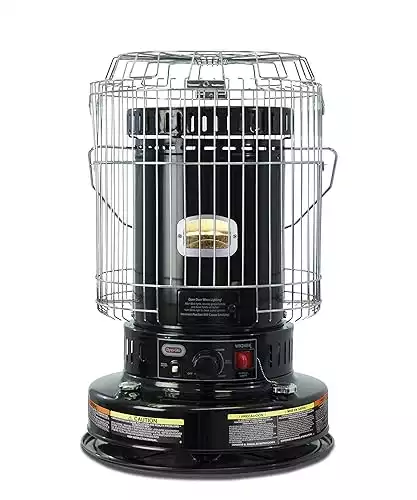 Dyna-Glo Indoor Kerosene Heater
Dyna-Glo Indoor Kerosene Heater
Best For: Everyday use, such as heating garages and heating inside your home during power outages.
Dyna-Glo is one of the leading names in kerosene heaters. Their 23,800 BTU convection heater is easy to use and the right size for most home uses.
Read the user manual before lighting this heater if you aren’t familiar with kerosene wick heaters. Once you do, you’ll find the Dyna-Glo 23,800 is pretty easy to use.
The heater uses only kerosene fuel. While some users claim they’ve cut the fuel with diesel to save costs, this isn’t recommended. Diesel is too dirty for this heater to handle. Read more about using diesel in a kerosene heater.
The fuel tank holds almost 2 gallons of kerosene. Once you light the heater, it heats a room VERY quickly. You might only get 4-5 hours of run time at maximum setting from a tank, though.
It’s easy to refill the tank because it lifts out. A fuel siphon is even included with the heater.
A cool thing about convection kerosene heaters designed like this (with a flat-topped safety grill) is that you can heat food on top of it – a great feature during power outages.
There are also all the standard safety features you’d want from an indoor heater.
- Radiant heater
- From 23,800 BTU
- 1.9-gallon fuel tank
- 8-12 hours operation per tank
- Emergency shutoff
- Fuel gauge
- Weight = 23lbs
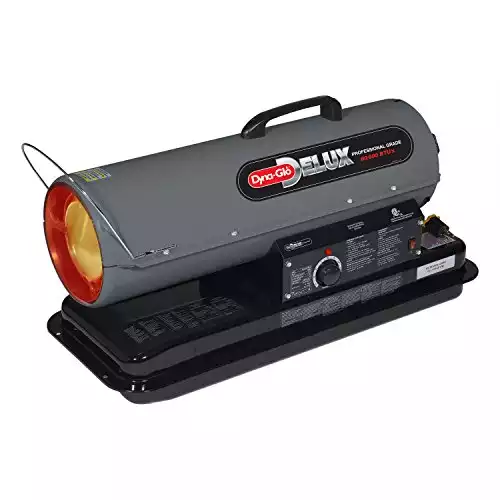 Dyna-Glo Delux Kerosene Forced Air Heater
Dyna-Glo Delux Kerosene Forced Air Heater
Best For: People who need a powerful heater for large spaces. You’ll want a generator to power the forced air for emergency heating.
This model of Dyno-Glo kerosene heater comes in different BTUs, from 50k to 220k. It lives up to its “Deluxe” name. There are lots of controls, and I particularly love that the fuel gauge shows how many hours of heating you have left.
With the 80k option, the heater can heat up to 1,900 square feet. And it will heat the space FAST! Of course, that amount of strength means you’ll go through fuel quickly.
A nice thing about Dyno-Glo is that they have good troubleshooting. If something isn’t running correctly, you can scan the QR code of the product, and it will ask you questions to help you figure out what is wrong.
The only downside of this heater is that it is a bit loud when running (which is expected of forced air kerosene heaters). Also, note that this is a forced-air heater. It needs to be plugged in for the fan to work.
- Radiant heater
- From 50,000 BTU
- 5-gallon fuel tank
- Thermostat
- 9 hours operation per tank
- Emergency shutoff
- Fuel gauge
- Weight = 27lbs
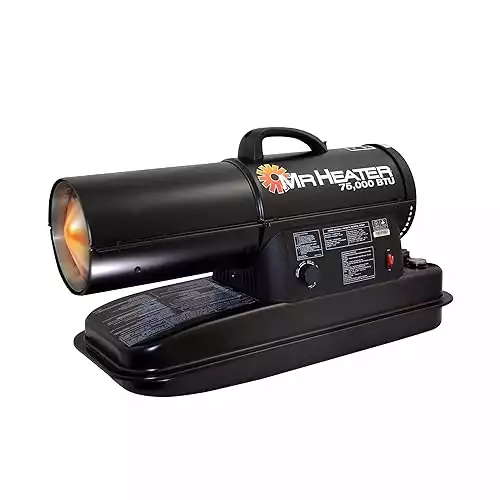 Mr. Heater MH75KTR Kerosene Heater
Mr. Heater MH75KTR Kerosene Heater
Best For: People who want a powerful heater that can run longer on a single tank. It also needs electricity to run the fan, so it isn’t suitable for power outages.
Mr. Heater makes several models of forced air kerosene heaters. Their 75K BTU option has a 6-gallon fuel tank that can run for 11 hours on kerosene. The best thing about the heater is probably how easy it is to use.
With the 75k heater, you can heat up to 1,875 square feet. The fuel tank is 6 gallons larger than other kerosene heaters of similar strength.
The larger tank size means the heater will run longer (about 11 hours), but the heater is heavier at nearly 40lbs.
If you have a bad back, you might want to get the Mr. Heater 125,000 BTU model instead, which is on wheels and easier to move.
Another reason to spring for the 125,000 BTU model is its built-in diagnostic tools like blinking LED lights. However, 125K BTU is too powerful for many indoor needs, so don’t decide based on this alone.
As expected with a forced-air heater, it’s loud when running. You will also need electricity for the heater fan, so it isn’t the best option for power outages unless you also have a generator.
- Forced air heater
- 75,000BTU
- 6-gallon fuel tank
- Thermostat
- 11 hours operation per tank
- Emergency shutoff
- Fuel Gauge
- Weight = 38lbs
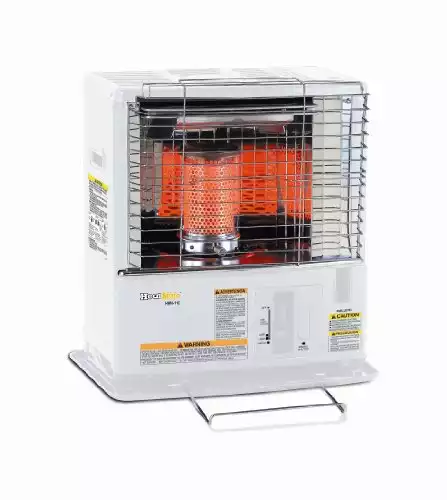 Sengoku HeatMate 10,000-BTU Portable Heater
Sengoku HeatMate 10,000-BTU Portable Heater
Best For: Great backup heater, primarily because of fuel efficiency. As a supplemental heater, it is only suitable for small spaces.
For such a small heater, this Sengoku heats surprisingly well. The key is in its efficiency. The tank is only 1.2 gallons but can heat up to 380 square feet for over 12 hours.
However, some users report that a tank lasts only 6 hours, even on a low setting. Run time can vary drastically depending on the quality of your kerosene.
Small heaters do come with their downsides, though. Heating a room will take a while, and it isn’t doing much for a large space.
You’ve also got to be very careful with the positioning of the wick. If it gets set too low, you can expect some bad odors.
- Radiant heater
- 10,000 BTU
- 1.2-gallon fuel tank
- 12-14 hours operation per tank
- Fuel gauge
- Emergency shutoff
- Weight = 20lbs
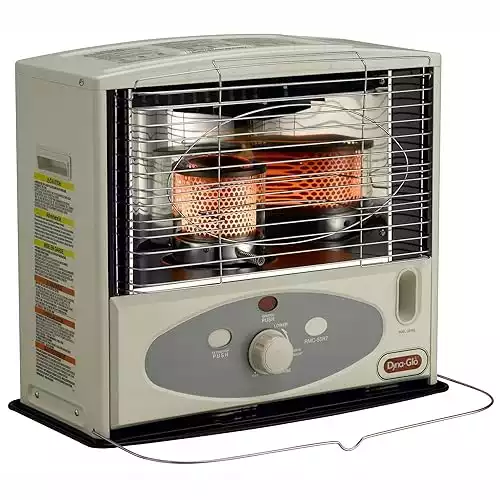 Dyna-Glo RMC
Dyna-Glo RMC
Best For: Wonderful emergency heater for locations that don’t get very cold. The fuel efficiency means it is also a good choice for supplemental heating.
At first glance, the fuel efficiency of this kerosene heater seems impressive. Yes, it can run for 13 hours on one tank – but it isn’t as hot as other heaters of equal rating.
That said, it is still a reliable heater that can heat up to 500 square feet. It is easy to use and has logical controls.
The only real issue with this Dyna-Glo heater is that the wick is hard to adjust. You don’t get much leeway in length, which means you can get nasty odors.
- Radiant heater
- 10,000 BTU
- 1-gallon fuel tank
- 13 hours operation per tank
- Emergency shutoff
- Weight = 21lbs
How Do Kerosene Heaters Work?
Unlike most other fuel-based heaters, kerosene heaters require a wick. The wick absorbs the kerosene. When ignited, it carries the flame into the kerosene fuel to light it and produces heat through combustion.
The design of the heater allows the amount of oxygen reaching the fuel to be regulated. The flame can also be controlled by increasing or decreasing the wick length.
Pros/Cons
Admittedly, kerosene heaters aren’t my first choice of backup heater. I have a wood-burning stove with a duct system that channels the heat throughout the home.
However, most people don’t have a reliable source of wood, nor do they want to chop lots of wood or install an expensive system “just in case.”
By comparison, kerosene heaters are reasonably cheap and don’t require any installation. You take out the heater as needed during emergencies.
Pros
Kerosene heaters are affordable
Come in different sizes
Quickly heats a small space or room
Kerosene is generally very cost-effective
Kerosene can be stored for long periods
Produces no smoke or fumes
Portable
Suitable for indoor or outdoor use
Cons
Units can be loud
Kerosene might not be readily available where you live
Open flame types can be a hazard
Fumes can cause health effects
Poor-quality fuel or incomplete burning can cause a bad odor
Unit has to be filled, which might result in spills
Is It Safe to Use Kerosene Heaters Indoors?
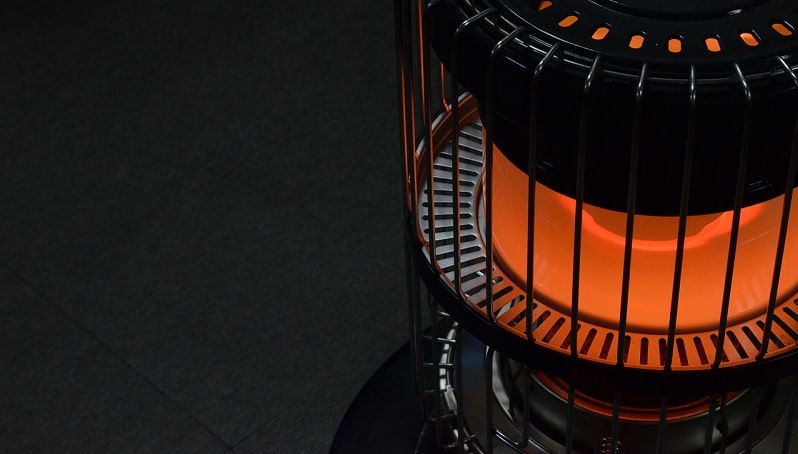
Yes, it is very safe, but there are always some best practices to follow, as with any combustion heater (including gas, propane, and wood).
Kerosene and Carbon Monoxide (CO)
Kerosene heaters (and oil, wood, gas, and propane heaters) burn oxygen in the air and release carbon monoxide. In addition to the CO, kerosene heaters can release other pollutants such as sulfur and nitrogen dioxide.
You must vent the heated room to reduce the risk of asphyxiation due to carbon monoxide poisoning!
This is as simple as leaving the door to an adjoining room open or opening a window 1 inch.
I would also recommend installing a carbon monoxide detector in your home.
As a general rule, you will need 1-4 square inches of fresh air ventilation for each 1000 BTU of heater capacity.
Toxic Fumes from Kerosene
Kerosene is a liquid, but it can evaporate into the air. When it evaporates, it can produce toxic fumes.
Generally, these fumes aren’t a big concern. People have long used kerosene for killing head lice and cleaning (though health agencies advise against this now).
However, to play it safe, you should ensure you aren’t exposed to kerosene fumes. Always refuel your kerosene heater outdoors.
Bad Odors
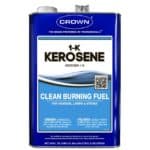
Kerosene heaters release some odor at maximum heat (usually about 45-60 minutes), but the smell should NOT be strong or nasty.
The odor should also stop after max heat has been reached. It is a sign of a problem if you get a foul smell from your kerosene heater.
Usually, a foul odor occurs because of low-quality fuel. The fuel might not be Grade K-1 or contaminated (if the fuel is old and wasn’t stored properly).
These fuels won’t burn completely, resulting in a bad smell.
Another cause of bad odors is incomplete burning, such as from too low a temperature or an incorrectly placed or sized wick.
Your kerosene heater should always be on high heat, with the temperature only turned down enough to prevent soot from forming.
Kerosene Heater Safety Best Practices
- Install a CO detector in your home.
- Ensure the room is well-ventilated – leave a door or window open.
- Never leave a kerosene heater unattended.
- Keep the instruction manual nearby.
- Choose a model with a BTU rating suited to the space you want to heat.
- Keep the wick at the proper length instructed by the manufacturer.
- Only use Grade K-1 kerosene
- Fuel should be clear; do not use yellow or red fuel
- Store kerosene in containers designed for kerosene
- Make sure your kerosene storage containers are clearly marked
- Refilling should only be done outdoors and when the unit is cool
- Use a siphon pump for refilling to prevent spilling
- Keep heater away from all flammable and combustible items (such as curtains, furniture, aerosol sprays, and gasoline)
Cleaning Up Spilled Kerosene
Spilled kerosene is potentially very dangerous, as it can catch on fire. Use a siphon to prevent spillage when refueling. If spilling does occur, follow this advice:
- Use rags to absorb as much of the spilled kerosene as possible. Large spills can be absorbed with kitty litter or sawdust.
- Don’t use water-based cleaners on kerosene. Water and kerosene don’t mix.
- Mix dish soap with warm water. Use it to wipe the area of the spill.
- If possible, use fans to speed up the evaporation of the kerosene fumes. Make sure the space is well-ventilated.
How to Add Fuel to Your Heater
A siphon is the safest way to add fuel to a kerosene heater. If you must manually pour to refuel, use a funnel and pour very carefully! Clean up any spills immediately.
Only fuel a kerosene heater when it is turned off and cool. Always take the heater or fuel container outdoors for refueling.
How to Store Fuel
Compared to other fuel types (such as gasoline), kerosene is very easy to store. It lasts a long time and won’t freeze or evaporate.
Make sure you have an approved container for storing the kerosene. You mustn’t use glass as it can absorb heat and cause the kerosene to ignite.
Most kerosene containers are plastic. Metal is the best option to store kerosene for long periods.
Kerosene containers are blue. Some people say it is okay to use gasoline containers to store kerosene. However, this is a terrible idea.
Aside from the potential for mix-ups, kerosene doesn’t last as long in plastic containers.
- Use clean, sealed containers for storing kerosene
- If possible, use metal containers for kerosene
- Keep away from heat and light
- Only store kerosene outdoors
- Kerosene can be frozen, but this will make it thicker and more challenging to pour
How Long Can Kerosene Be Stored?
As a general guideline, kerosene lasts 1-3 months. To play it safe, you should discard and replace any kerosene not used by the end of the heating season.
However, many people report storing kerosene for years (even as much as 10+ years) without problems. This old kerosene will still burn, but tainted kerosene could damage your heater or cause foul odors when burning.
Testing Kerosene Quality
If you aren’t sure whether your kerosene is still “good” or not, you can use this visual testing method.
- Put a small amount of kerosene in a clean glass jar.
- Let it sit for 1 hour.
- Quality kerosene will not have any debris or bubbles. It will be clear.
- Tainted kerosene will be yellow or cloudy have bubbles or visible contaminants.
When quality kerosene is burned, it won’t produce an odor after reaching the ideal burn temperature.
If you see smoke or sense a bad smell, the kerosene shouldn’t be used.
Care and Maintenance
The most important thing you need to know about kerosene heater maintenance is that the wick needs regular care. You can read instructions on how to care for a wick here.
You’ll have to check the manufacturer’s guidelines for your specific kerosene heater. Here are some general guidelines:
- Store the fuel tank separately from the rest of the heater
- Only use K-1 kerosene for cleaning the inside of the fuel tank
- Use a nonflammable cleaner (such as water with ammonia) to clean the heater’s outside.
- After every 2-3 refuelings, the wick should be “dry burned” and brushed.



Very useful information what would you use in a small tent for very cold weather
It’s hard to safely heat a small tent because of CO poisoning and fire risks. There are some small propane heaters which work. Also, UCO makes a small candle heater.
I got my vertical kero heater and have use it 2 times so far. I found it very useful in supplying additional heat in out small home. But, it comes at a high price as far as fuel is concerned.
I live near Galveston,Texas and can only find K-1 at our HD,Lowe’s,and Walmart. NOT at any gas station though. HD and Lowe’s sells it by the gallon or 2 1/2 gallon clear plastic jugs. One gallon costs $10, while a 2 1/2 gallon jug costs $25.50. NOT cheap is right.
I read when you use the heater for 2 to 3 you have to dry clean the wick with a brush. I hate the fact that ya have to take the heater apart to do this. I will research that more. If someone knows a way to do this w/o taking it apart, let me know. Regards, Ed 77563
Personally I don’t like the smell so I use Fire Fly Fuel, the cost per gallon is more however it burns cleaner and longer. No smell and non-flammable.
Give it a try, I think you’ll like it!
Thank you for such a great website~! I lucked out and found a vintage 1981 Sears Kerosene heater for $5 at a thrift store. It looked awful with chipped paint, rusty cage hanging part way off, dirt everywhere, so I guess the staff didn’t know what a great old gem they had. I knew nothing, but do a lot of repairs on all kinds of things, l so I bought it quick and have ben studying over the last few days. It turns out this really was a great buy. It’s the type with a large attached cage, has the attached “drip tray” underneath, has a tip-over switch, and an auto ignition run by two batteries … but it can be lit with a match instead. At 22,600 BTU it should be perfect for power-outage emergencies. Also, I have cats, so with it being too heavy for them to dump over, and with the attached protective cage, it’s all good.
I worried I’d have an awful time learning what it needed and then finding parts. However, after cleaning and taking this thing apart from stem to stern, examining and studying every detail, it turns out this lovely item really needs nothing other than what I choose to get for it (a lever-type knob for the “on-off” switch, and a front cover behind the wick adjuster knob, both of which I have made). If parts are ever desperately needed, yep, it will likely be a pain. But for now, proper wicks are still available, and with good care, perhaps it will last as long as needed. Can’t believe the good luck. Christmas came early.
Because this type of old heater is so ugly (meaning the ugly tan enameling), I quick painted it with a high-heat rust-colored gloss enamel which transformed it into a beauty. What a joy a lovely color can bring.
The information on your website has made me even more pleased about this 40-year old find easily made rather new. Thank you again~!
I have never used a Kerosene or propane heater. I have Kerosene and I was a little nervous about using it, I would be just as nervous with propane. I bought it just in case of an emergency, my husband is handicapped and isn’t able to help me with this. Thank you for very clear information on these Kerosene heaters.. It’s made me feel more relaxed about it.
Thanks for the deltailed information! I live in an apartment in Texas and I want to be prepared in case we have another winter storm. I don’t have an outside storage room or garage but I do have a small yard. What’s the best way to store kerosene outside in a hot climate?
Good question. We will work on a post about that!
Great advice! I am looking to buy a kerosene heater so Googled about safety and your page popped up! Thank you so much I’ve learned a lot by reading your wealth of information! Great stuff!~Dawn in NY
It’s amazing how thorough you are on every topic. This site is really a huge resource. – I grew up using a Kero-Sun kerosene heater in the basement during cold Connecticut winters & it always helped a lot. It was easy to use, cheap to operate & was very safe. Definitely a smart purchase if you live in a cold climate.
Damian – thrilled and delighted to hear that, our aim is to go deep on everything we cover so its great to get this kind of feedback.
I have a wood burning stove rated for my house capacity but wood buying is a real crap shoot! We never know if the wood we buy is properly seasoned to burn properly. Apart from kerosene heaters and wood burning we have no other means of staying warm.
If you hear the heated, “burning” wood sizzling, or see moisture boiling off at the end of the piece, it is green wood, and is building creosote in your chimney as it burns. Eventually, in a hot fire, the creosote build-up will ignite, and the result is a fire IN THE CHIMNEY! Many, many, houses have burnt to the basement from a creosote chimney fire. Keep that chimney cleaned out, and only burn seasoned wood.
I also got a couple of old perfection kerosene heaters for the living area. A vintage Haller saffire for my room 14x14ft it uses blue flame in the form of a blue ring, it doesn’t heat that well as this is SC it’s not a big deal but it heats it up to around 65f. Kinda wish it was a tiny bit stronger
I have a 55 gallon blue plastic drum I keep outside, we are planning to stockpile during summer months at least get it full so as to avoid frequent trips and possible higher prices. Any suggestions will be much appreciated